QUESTIONS
-
- Give the meaning of biology. (1mrk).
- State and explain the two major branches of biology(.2mrks)
- Give three importance’s of studying biology? (3mrks)
- Name and explain the eight characteristics of living things. (8mrks)
- Motor vehicles move, use energy and produce carbon (iv) oxide and water. Similar characteristics occur in living organisms yet motor vehicles are not classified as living. EXPLAIN. (3mrks)
- Why is nutrition important in living organisms. (2mrks)
- Identify the following apparatus as used in biology and for each, give the function and an example of organism collected. (12mrks)
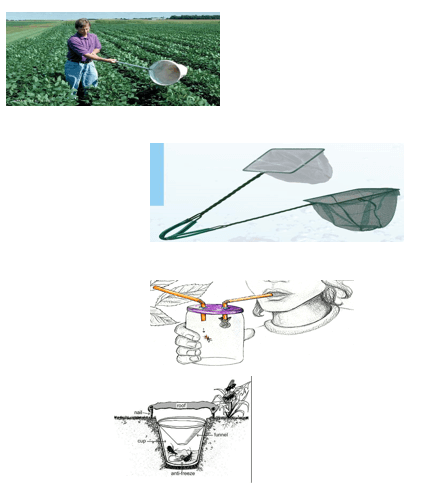
- Distinguish between the following terms.
- Taxon and taxonomy (2mrks)
- Genus and species(2mrks)
- Give 4 differences between plants and animals. (4mrks)
- What do you understand by the term binomial nomenclature? (2mrks)
- A student observing a leg of an insect under a hand lens made a drawing of the leg whose length was 4cm with a magnification of X2. What was the actual length of the length.? (2mrks)
- A form one student, trying to estimate the size of onion cells observed the following on microscope’s field of view
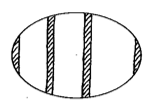
- He counted 20 cells across the field of view. Calculate the size of one cell in micrometers. ( 2mks)
- State the function of the following parts in a microscope. (5mks)
- Mirror.
- Condenser
- Body tube
- Revolving nose-piece
- Fine adjustment knob.
- Name the organelle shown in the diagram above and give its functions (2mk

- State functions of the following cell structures.
- Vacuoles, 1mk
- Nucleolus, 1mk
- In which two ways are the organelles chloroplast and mitochondria similar. 2mks
- What is meant by resolving power of a microscope. 2mks
- Give the function for the following process when preparing temporary slides. 3mks
- Sectioning
- fixation.
- Addition of iodine solution, to an onion epidermis on a slide while being observed on a light microscope.
- Give the meaning of the following terms, giving an example in each case. (6mrks)
- A tissue
- An organ
- An organ system.
MARKING SCHEME
- Give the meaning of biology.(1mrk)
- study of living things.
- State and explain the two major branches of biology(.2mrks)
- Botany.study of plant.
- Zoology. Study of animals
- Give three importances of studying biology ?( 3mrks)
- Enables one to pursue careers such as medicine,dentistry
- Imparts scientific skills
- Knowledge in bioogy is usefull in enhancing international cooperation in medicine and environmental conservation
- List and explain the characteristics of living things.(8mrks)
- Nutrition is the process by which living things acquire and utilise nutrients.
- Respiration This is the process in which food substances are broken down in the body to release energy.
- Movement’s a change in position by either a part of or the whole living thing. When a whole organism moves from one place to another(locomotion)
- Irritability is the ability of organisms to sense changes of the environment and to respond to them e.g. living things react to changes in temperature, humidity light, pressure etc.
- Reproduction, is the process by which living organisms give rise to young ones of their kind.
- Growth and Development
Growth- it’s the process by which organisms permanently increase in size and mass.
Development- refers to irreversible change in the complexity of the structure of living things.
- Motor vehicles move, use energy and produce carbon dioxide and water. Similar characteristics occur in living organisms yet motor vehicles are not classified as living.EXPLAIN.(3mrks)
- Motor vehicles do not show Reproduction,Irritability and growth
- Why is nutrition important in living organisms.(2mrks)
- Organisms acquire nutrients and food substances necessary for growth and development,
- Identify the following apparatus as used in biology and for each,give the function and an example of organism collected.(12mrks)

Sweep net- This is used for catching flying insects.Bees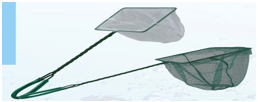
Fish net- This is used for trapping small fish and other small water animals.crabs,shrimp
Pooter- This is used for sucking small animals from rock surfaces or barks of trees.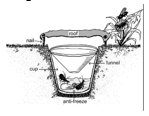
Pit fall trap- This is used for catching crawling animals.ants.
- Distinguish between the following terms.
- Taxon and taxonomy (2mrks)
- a group in classification.
- study of classification
- Genus and species(2mrks)
- Genus is a group In classification whose members do not interbreed and if they interbreed give rise to non-viable offspring.
- Species is the smallest unit of classification whose members share many similarities and can freely interbreed to give rise to fertile or viable offsprings.
- Taxon and taxonomy (2mrks)
- Give 4 differences between plants and animals.(4mrks)
Plants
Animals
Most possess chlorophyll which gives them their green colour. Chlorophyll is very useful in the process of photosynthesis.
lack chlorophyll pigment hence feed on already manufactured food materials.
Their cells have cellulose cell walls
Their cells lack cellulose cell walls
respond slowly to changes in their environment.
respond quickly to changes in the environment.
Plants are immobile
Most animals move about in search of food, shelter and mates.
They lack specialized excretory organs
Have complex excretory organs
- What do you understand by the term binomial nomenclature?(2mrks)
- Scientific naming system which involves assigning an organism two names ;genus and species
- Astudent observing a leg of an insect under a hand lens made a drawing of the leg whose length was 4cm with a magnification of X2.What was the actual length of the length.?(2mrks)
- Drawing magnification= Length of the drawing
Length of the actual object
2=4cm/actual length.
Actual length=4cm/2 =2cm
- Drawing magnification= Length of the drawing
- A form one student, trying to estimate the size of onion cells observed the following on microscope’s field of view
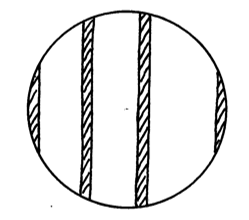
He counted 20 cells across the field of view. Calculate the size of one cell in micrometres.( 2mks)- Size of cell = Diameter of field of view;
No. of cells
= 3000 NM = 150 μm;
20 rej. wrong unit - State the function of the following parts in a microscope. (5mks)
- Mirror.
- Condenser
- Body tube
- Revolving nose-piece
- Fine adjustment knob.
- Size of cell = Diameter of field of view;
- Name the organelle shown in the diagram above and give its functions (2mk)

- Mitochondrion, site for respiration
- State functions of the following cell structures.
- Vacuoles stores food,contributes to the osmotic properties of the cell. 1mk
- Nucleolus, manufacture of ribosome. 1mk
- In which two ways are the organelles chloroplast and mitochondria similar. 2mks
- Double membrane
- Suspended in cytoplasm
- What is meant by resolving power of a microscope. 2mks
- The ability of a microscope to separate images of objects; that lie close to one another;
- Give the function for the following process when preparing temporary slides. 3mks
- SectioningTo allow light pass through the section
- fixation.Maintain structure of specimen or to make specimen hard enough for thin sections to be cut
- Addition of iodine solution, to an onion epidermis on a slide while being observed on a light microscope. Stains/ colours parts of the cell making it more visible/ clear
-
- Give the meaning of the following terms ,giving an example in each case.(6mrks)
- Tissue these are cells of a particular type grouped together to perform a certain function animal tissues include epithelium, blood, nerves, muscle, skeletal and connective tissues plant tissues include epidermal, photosynthetic, vascular, strengthening tissues
Organ several tissues combined together to perform a particular function animal examples include heart, liver, kidney, lungs, brain, blood vessels, muscles, skeleton Plant organs include leaves, roots, flowers, and stem. - Organ system animal systems include excretory, digestive, respiratory, nervous, circulatory, endocrine(hormones/glands), skeletal systems plant systems include transport system
- Tissue these are cells of a particular type grouped together to perform a certain function animal tissues include epithelium, blood, nerves, muscle, skeletal and connective tissues plant tissues include epidermal, photosynthetic, vascular, strengthening tissues
- Give the meaning of the following terms ,giving an example in each case.(6mrks)
Download Biology Questions and Answers - Form 1 End Term 1 Exams 2022.
Tap Here to Download for 50/-
Get on WhatsApp for 50/-
Why download?
- ✔ To read offline at any time.
- ✔ To Print at your convenience
- ✔ Share Easily with Friends / Students

